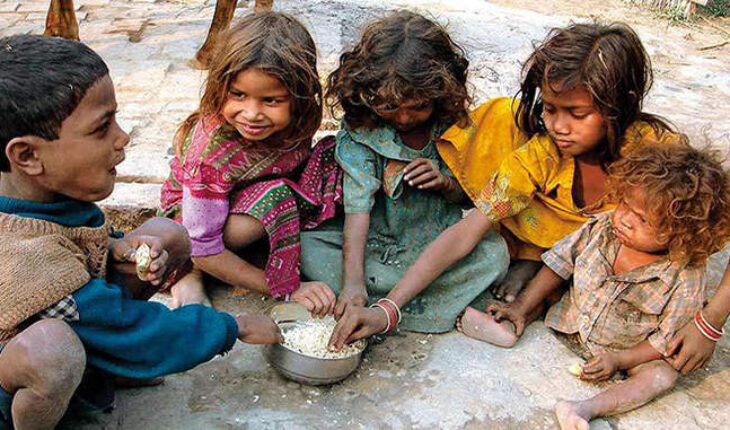
Lagging behind most south Asian countries, India has ranked 107th on Global Hunger Index 2022 out of 121 countries ranked.
With a score of 29.1, the level of hunger in India has been rated as ‘serious’ by European NGOs, Concern Worldwide and Welthungerhilfe, the publishers of the Global Hunger Index in India slipped six places from its 2021 ranking of 101 among 116 countries. Last year, the country’s score was 28.2. Almost all of India’s neighbours fared well with Pakistan, Sri Lanka, Bangladesh, Nepal, and Myanmar ranking 99, 64, 84, 81, and 71, respectively. With a score of less than five, China has topped the chart with 16 other countries.
Those who ranked below India are Afghanistan, Zambia, Sierra Leone, Liberia, Niger, Haiti, Central African Republic, Yemen, Chad, the Democratic Republic of the Congo, Lesotho, Timor-Leste, Guinea-Bissau and Madagascar.
Malnutrition has been prevalent for decades in India and is the primary cause of poverty and economic fallout. 22.4 crore people in India have considered undernourished India’s rank in the Global Hunger Index is near the bottom.
According to the NFHS-5data, there is more stunting in rural areas (37.3 per cent) as compared to urban centres (30.1 per cent), owing to the poor socio-economic situation in rural areas. Anaemia among children under five has worsened, with a prevalence of nearly 67.1% compared to 58.6% recorded in the NFHS’s 4th round, while 57% of women of reproductive age are anaemic. About 70% of children up to age 6 are anaemic in Haryana which is greater than the national average which is 67.1%. The infant mortality rate(35.2) has improved if we compare it with NFHS-4 but the prevalence of anaemia is chronic in Haryana and it is among the top 5 states in India as for as the extent of anaemia is concerned. The more alarming thing about the national average is the 8 percentage points rise in the fraction of children suffering from anaemia from 59% in NFHS-4 to 67% in NFHS-5. About 27.5% of children are stunted and 21.5% are underweight in Haryana in the age group of 0-5 years. According to a report, anaemia is found more chronic in women in comparison to men. In India, About 59% of females are anaemic in the age group of 15-19 and 57% in the age group 15-49, whereas in Haryana 62% of women are anaemic in the age group of 15-19 and 60.4% are anaemic in the age group of 15-49. Poorest Indian states have infant mortality rates higher than those in sub-Saharan Africa. India accounts for 17% of global maternal deaths, and 21% of deaths among children below five years.
The Global Hunger Index scores are determined based on the values of four component indicators – child mortality, child stunting, child wasting and undernourishment. The Index, published annually, tracks hunger globally as well as by region and country.
There is already enough food to feed everyone in the world; those going hungry just lack access. Global trade moves food grain from where it is produced to where it is consumed, keeping people fed. Russia and Ukraine are two of the world’s largest agricultural producers, whose food exports account for some 12 per cent of total calories traded in the world. The war is ruining a quarter of the global grain trade. Some 50 nations that rely on Russia and Ukraine for the bulk of their wheat imports—including Bangladesh, Egypt, Iran, and Türkiye—have been trying to find alternative suppliers. In March 2022, global food prices jumped to their highest levels ever recorded. Compared with the previous year, prices for cereals were up 37 per cent; cooking oils, 56 per cent; and meat, 20 per cent. As of July, prices have fallen slightly since March, but in June they were still 27 per cent higher than in June 2021 (FAO 2022c). The global hunger situation as reflected in the 2022 GHI is grim. The overlapping crises facing the world are exposing the weaknesses of food systems, from global to local, and highlighting the vulnerability of populations around the world to hunger. Despite the “Zero Hunger” target articulated in the Sustainable Development Goals, the progress that has been made is being lost, and the situation is worsening in too many countries. It is critical to act now to halt and reverse the forces driving hunger and undernutrition and to take steps to build a more resilient, just, and sustainable world where hunger is a thing of the past. There can be no more excuses. At the same time, we must reduce food loss and waste. Currently, close to a third of all food produced around the globe—enough to feed about 1.26 billion people a year—is lost or wasted at some point in the food supply chain (FAO 2022f). If we could cut food loss and waste in half, the food supply would contain enough fruits and vegetables to cover the recommended amount of 400 grams per person per day. Inefficiencies along the food supply chain and food waste from the wholesale to the consumer level also have a major impact on the environment. The wastage culture has been bad news for decades in India which produces some of the world’s best rice, grains, tea and spices. In 2021-22, total food grain production was estimated at 315,72 million tonnes, while as per estimates, 225-230 MT is needed to feed its population in a year. Still, the country is struggling to feed its own.
The United Nations Food and Agriculture Organization (FAO) estimates that more than 40 per cent of food produced is wasted in India, and its costs could be as high as US$14 billion (12.42 billion euros) every year. Limiting food loss and waste can therefore help to both fight hunger and reduce environmental harm. Achieving “Zero Hunger” was always going to be an enormous challenge. This is because ending hunger is not a simple matter of producing more food. Hunger cannot be eradicated unless we tackle the structural drivers that cause it: war, climate change, and recession. If current conditions continue, there would still be at least 670 million, undernourished people, among us in 2030. We may not be able to end hunger by then, but we can stop heading in the wrong direction. The world will not end in 2030. Nor should the fight against hunger.
Dr.Harvinder Kaur, Associate Professor in Economics, Ambala, views are personal.





